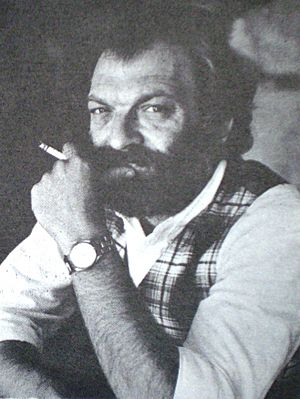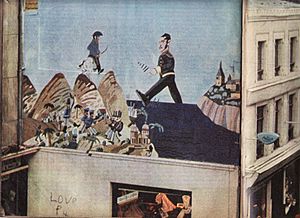Antonio Seguí facts for kids
Quick facts for kids
Antonio Seguí
|
|
|---|---|

Antonio Seguí, c. 1980.
|
|
| Born |
Antonio Hugo Seguí
11 January 1934 Córdoba, Argentina
|
| Died | 26 February 2022 (aged 88) Buenos Aires, Argentina
|
| Known for | Painting, printmaking |
| Awards | Instituto Torcuato Di Tella Award (1989), Konex Platinum Award: Graphic (2002) |
Antonio Hugo Seguí (born January 11, 1934 – died February 26, 2022) was a famous artist from Argentina. He was a cartoonist, painter, printmaker, book illustrator, and sculptor. He lived and worked in Paris, France, for most of his life. His art is shown in many famous museums around the world, like the MoMA in New York and the Centre Georges Pompidou in Paris.
About His Life
Antonio Seguí was born in Córdoba, Argentina. He grew up in a regular family and was the oldest of four children.
When he was young, from 1951 to 1954, he traveled a lot. He visited countries in Europe and Africa. During this time, he studied art in famous schools. He learned about painting and sculpture in Madrid, Spain, and in Paris, France.
After his travels, he went back to Argentina. He worked for a magazine called Orientación. This magazine supported a politician named Arturo Frondizi who wanted to become president.
In 1957, Antonio Seguí had his very first art show in Argentina. He also traveled through countries in South and Central America. He studied printmaking in Mexico. In 1961, he returned to Argentina. Then, in 1963, he moved to Paris, France. He lived and worked there until he passed away in 2022, when he was 88 years old.
His Art Style

Antonio Seguí's artworks often have a funny, playful side. He used his art to comment on society and how people act. But his art also had a beautiful, poetic feeling that went beyond just making jokes.
One special thing you'll notice in his drawings and paintings are small men wearing hats. Seguí said these figures came from his childhood memories. Back then, many men wore hats when they were out in public.
A common theme in Seguí's art is city life and the people who live in it. He often showed crowds of people who look like busy robots. They seem to be following the same paths that lead nowhere special. If you look closely, each person is different and doing their own thing. But from far away, they all blend together into a complex pattern, like a maze.
In many of his paintings, a huge crowd of figures covers the whole canvas. Examples include Gente de las azoteas (1992) and Pasar desapercibido (2001). But he also focused on single people in other works, like Sacando la Lengua (1965).
Seguí also often showed figures dancing tango in his art. He felt that tango was a very important part of Argentinian culture. He even made several artworks about the famous tango singer Carlos Gardel. In some of these works, he seemed to compare dancing the tango to the act of painting.
Antonio Seguí was inspired by other artists like Fernand Léger. From the 1960s, he started painting in a "figurative" style. This means his art showed real people and objects. However, he often changed the shapes of people in a way that looked a bit like children's art or "outsider art" (art made by people without formal training). You can also see some "cubist" ideas in his work. This is shown by how he repeated city elements and how important lines and colors were in his art.
Awards and Honours
Antonio Seguí won many awards and was recognized for his art throughout his career. Here are some of them:
- Grand Prize at the Tokyo Biennial (1966)
- First International Prize of Darmstadt (1967)
- Grand Prize at the Carcovia Biennial, Poland (1967)
- Grand Prize at the Biennial of San Juan, Puerto Rico (1968)
- Grand Prize at the Salon de Montrouge, France (1977)
- Konex Prize for Expressionist Painting (1982)
- Instituto Torcuato Di Tella Award (1989)
- Grand Prize National Fund of the Arts (1990)
- Gold Medal at the Norwegian International Graphic Triennial (1991)
- Konex Painting Prize (1992)
- Konex Platinum Award: Graphic (2002)
- He was also a member of the French Academy of Sciences and Arts.
See Also
 In Spanish: Antonio Seguí para niños
In Spanish: Antonio Seguí para niños

